Mahesh Subedar
Parameter-Efficient Active Learning for Foundational models
Jun 14, 2024Abstract:Foundational vision transformer models have shown impressive few shot performance on many vision tasks. This research presents a novel investigation into the application of parameter efficient fine-tuning methods within an active learning (AL) framework, to advance the sampling selection process in extremely budget constrained classification tasks. The focus on image datasets, known for their out-of-distribution characteristics, adds a layer of complexity and relevance to our study. Through a detailed evaluation, we illustrate the improved AL performance on these challenging datasets, highlighting the strategic advantage of merging parameter efficient fine tuning methods with foundation models. This contributes to the broader discourse on optimizing AL strategies, presenting a promising avenue for future exploration in leveraging foundation models for efficient and effective data annotation in specialized domains.
Improving Robustness and Efficiency in Active Learning with Contrastive Loss
Sep 13, 2021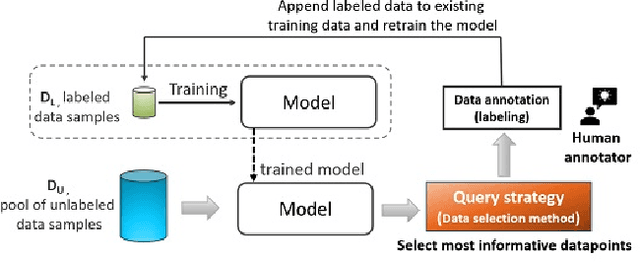
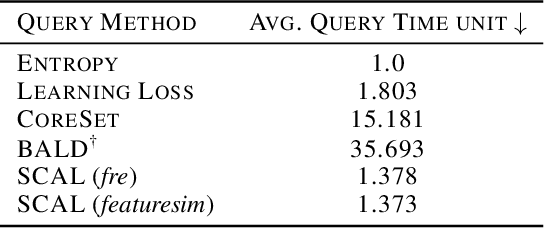
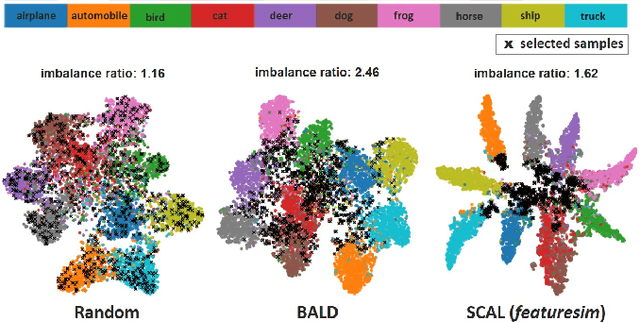
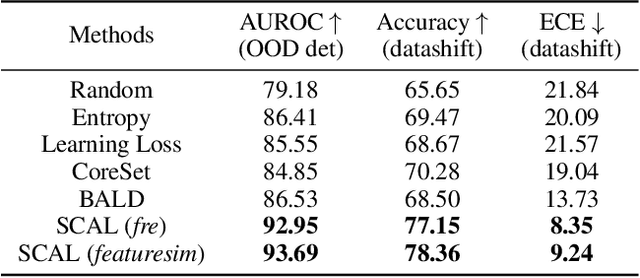
Abstract:This paper introduces supervised contrastive active learning (SCAL) by leveraging the contrastive loss for active learning in a supervised setting. We propose efficient query strategies in active learning to select unbiased and informative data samples of diverse feature representations. We demonstrate our proposed method reduces sampling bias, achieves state-of-the-art accuracy and model calibration in an active learning setup with the query computation 11x faster than CoreSet and 26x faster than Bayesian active learning by disagreement. Our method yields well-calibrated models even with imbalanced datasets. We also evaluate robustness to dataset shift and out-of-distribution in active learning setup and demonstrate our proposed SCAL method outperforms high performing compute-intensive methods by a bigger margin (average 8.9% higher AUROC for out-of-distribution detection and average 7.2% lower ECE under dataset shift).
Mitigating Sampling Bias and Improving Robustness in Active Learning
Sep 13, 2021



Abstract:This paper presents simple and efficient methods to mitigate sampling bias in active learning while achieving state-of-the-art accuracy and model robustness. We introduce supervised contrastive active learning by leveraging the contrastive loss for active learning under a supervised setting. We propose an unbiased query strategy that selects informative data samples of diverse feature representations with our methods: supervised contrastive active learning (SCAL) and deep feature modeling (DFM). We empirically demonstrate our proposed methods reduce sampling bias, achieve state-of-the-art accuracy and model calibration in an active learning setup with the query computation 26x faster than Bayesian active learning by disagreement and 11x faster than CoreSet. The proposed SCAL method outperforms by a big margin in robustness to dataset shift and out-of-distribution.
Partially-supervised novel object captioning leveraging context from paired data
Sep 10, 2021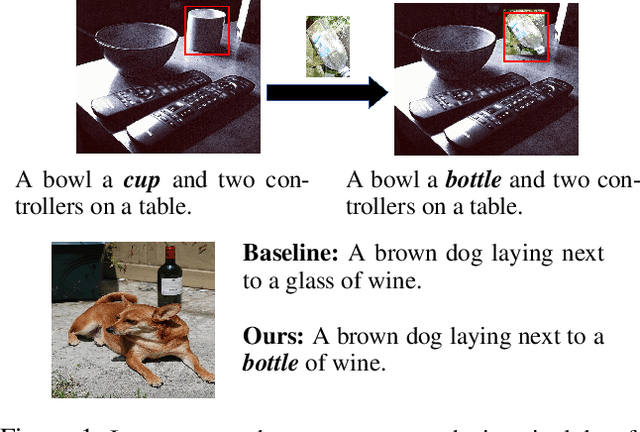

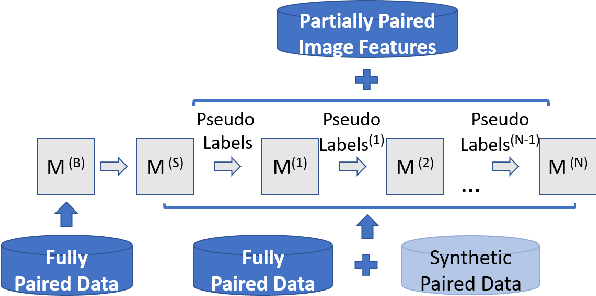

Abstract:In this paper, we propose an approach to improve image captioning solutions for images with novel objects that do not have caption labels in the training dataset. Our approach is agnostic to model architecture, and primarily focuses on training technique that uses existing fully paired image-caption data and the images with only the novel object detection labels (partially paired data). We create synthetic paired captioning data for these novel objects by leveraging context from existing image-caption pairs. We further re-use these partially paired images with novel objects to create pseudo-label captions that are used to fine-tune the captioning model. Using a popular captioning model (Up-Down) as baseline, our approach achieves state-of-the-art results on held-out MS COCO out-of-domain test split, and improves F1 metric and CIDEr for novel object images by 75.8 and 26.6 points respectively, compared to baseline model that does not use partially paired images during training.
Data augmentation to improve robustness of image captioning solutions
Jun 10, 2021
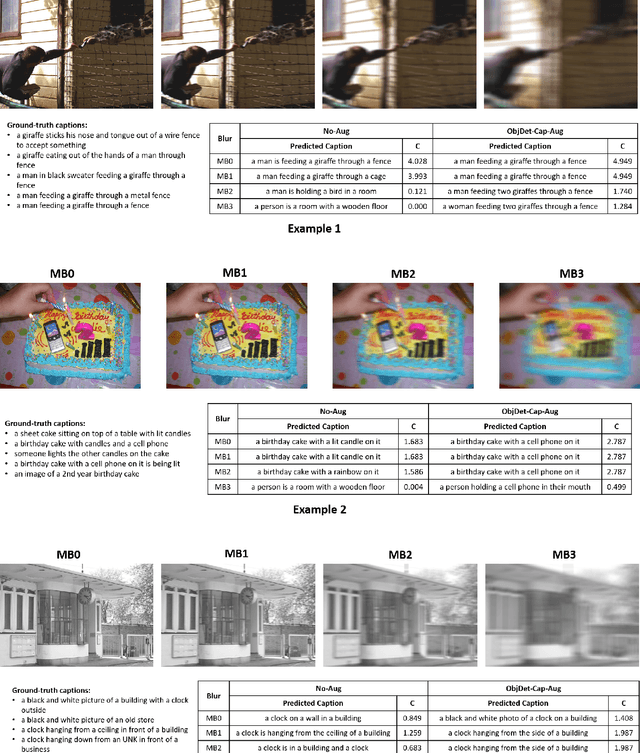
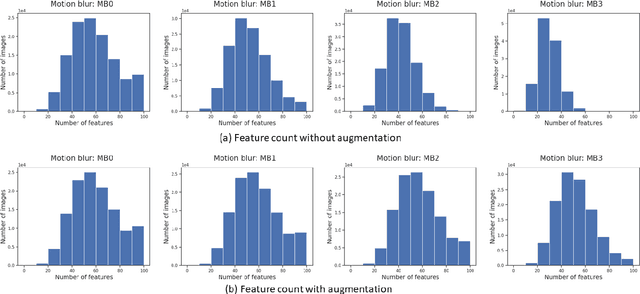
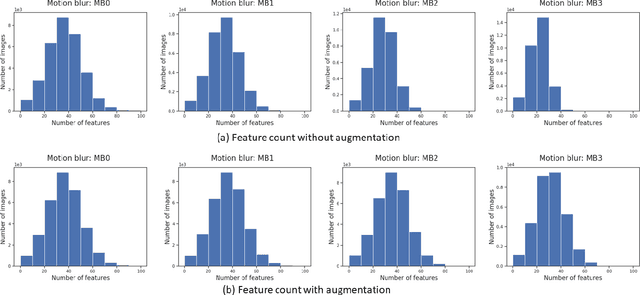
Abstract:In this paper, we study the impact of motion blur, a common quality flaw in real world images, on a state-of-the-art two-stage image captioning solution, and notice a degradation in solution performance as blur intensity increases. We investigate techniques to improve the robustness of the solution to motion blur using training data augmentation at each or both stages of the solution, i.e., object detection and captioning, and observe improved results. In particular, augmenting both the stages reduces the CIDEr-D degradation for high motion blur intensity from 68.7 to 11.7 on MS COCO dataset, and from 22.4 to 6.8 on Vizwiz dataset.
B-SCST: Bayesian Self-Critical Sequence Training for Image Captioning
Apr 06, 2020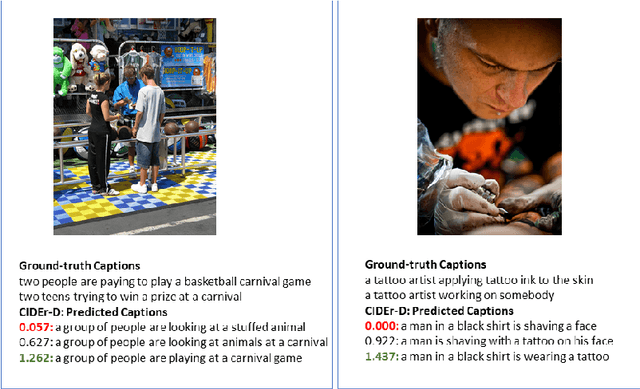

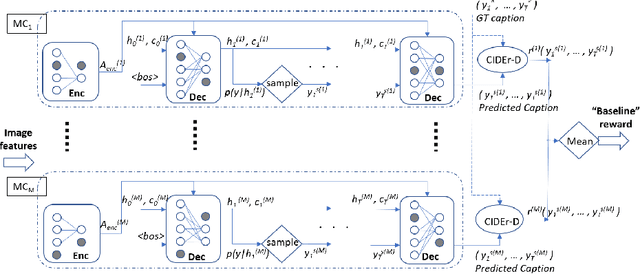
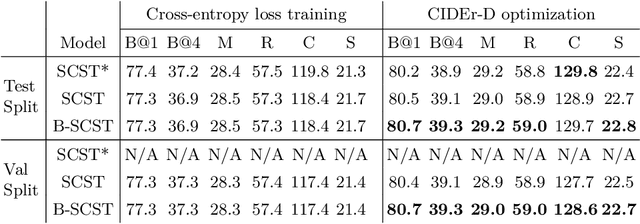
Abstract:Bayesian deep neural networks (DNN) provide a mathematically grounded framework to quantify uncertainty in their predictions. We propose a Bayesian variant of policy-gradient based reinforcement learning training technique for image captioning models to directly optimize non-differentiable image captioning quality metrics such as CIDEr-D. We extend the well-known Self-Critical Sequence Training (SCST) approach for image captioning models by incorporating Bayesian inference, and refer to it as B-SCST. The "baseline" reward for the policy-gradients in B-SCST is generated by averaging predictive quality metrics (CIDEr-D) of the captions drawn from the distribution obtained using a Bayesian DNN model. This predictive distribution is inferred using Monte Carlo (MC) dropout, which is one of the standard ways to approximate variational inference. We observe that B-SCST improves all the standard captioning quality scores on both Flickr30k and MS COCO datasets, compared to the SCST approach. We also provide a detailed study of uncertainty quantification for the predicted captions, and demonstrate that it correlates well with the CIDEr-D scores. To our knowledge, this is the first such analysis, and it can pave way to more practical image captioning solutions with interpretable models.
Deep Probabilistic Models to Detect Data Poisoning Attacks
Dec 03, 2019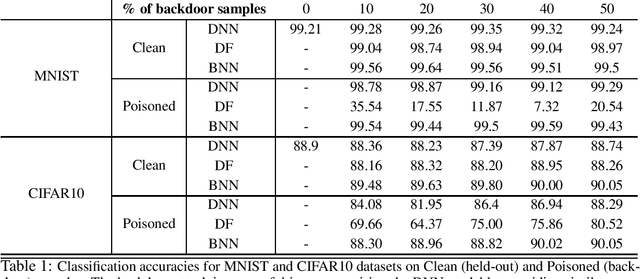


Abstract:Data poisoning attacks compromise the integrity of machine-learning models by introducing malicious training samples to influence the results during test time. In this work, we investigate backdoor data poisoning attack on deep neural networks (DNNs) by inserting a backdoor pattern in the training images. The resulting attack will misclassify poisoned test samples while maintaining high accuracies for the clean test-set. We present two approaches for detection of such poisoned samples by quantifying the uncertainty estimates associated with the trained models. In the first approach, we model the outputs of the various layers (deep features) with parametric probability distributions learnt from the clean held-out dataset. At inference, the likelihoods of deep features w.r.t these distributions are calculated to derive uncertainty estimates. In the second approach, we use Bayesian deep neural networks trained with mean-field variational inference to estimate model uncertainty associated with the predictions. The uncertainty estimates from these methods are used to discriminate clean from the poisoned samples.
MOPED: Efficient priors for scalable variational inference in Bayesian deep neural networks
Jun 12, 2019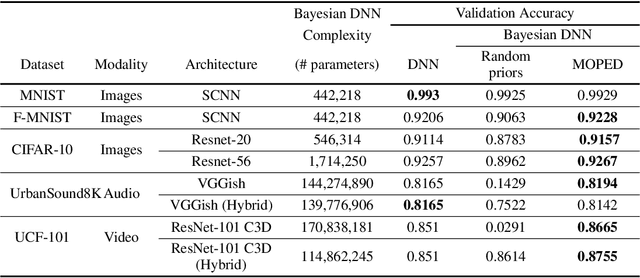



Abstract:Variational inference for Bayesian deep neural networks (DNNs) requires specifying priors and approximate posterior distributions for neural network weights. Specifying meaningful weight priors is a challenging problem, particularly for scaling variational inference to deeper architectures involving high dimensional weight space. We propose Bayesian MOdel Priors Extracted from Deterministic DNN (MOPED) method for stochastic variational inference to choose meaningful prior distributions over weight space using deterministic weights derived from the pretrained DNNs of equivalent architecture. We evaluate the proposed approach on multiple datasets and real-world application domains with a range of varying complex model architectures to demonstrate MOPED enables scalable variational inference for Bayesian DNNs. The proposed method achieves faster training convergence and provides reliable uncertainty quantification, without compromising on the accuracy provided by the deterministic DNNs. We also propose hybrid architectures to Bayesian DNNs where deterministic and variational layers are combined to balance computation complexity during prediction phase and while providing benefits of Bayesian inference. We will release the source code for this work.
BAR: Bayesian Activity Recognition using variational inference
Dec 01, 2018



Abstract:Uncertainty estimation in deep neural networks is essential for designing reliable and robust AI systems. Applications such as video surveillance for identifying suspicious activities are designed with deep neural networks (DNNs), but DNNs do not provide uncertainty estimates. Capturing reliable uncertainty estimates in safety and security critical applications will help to establish trust in the AI system. Our contribution is to apply Bayesian deep learning framework to visual activity recognition application and quantify model uncertainty along with principled confidence. We utilize the stochastic variational inference technique while training the Bayesian DNNs to infer the approximate posterior distribution around model parameters and perform Monte Carlo sampling on the posterior of model parameters to obtain the predictive distribution. We show that the Bayesian inference applied to DNNs provide reliable confidence measures for visual activity recognition task as compared to conventional DNNs. We also show that our method improves the visual activity recognition precision-recall AUC by 6.2% compared to non-Bayesian baseline. We evaluate our models on Moments-In-Time (MiT) activity recognition dataset by selecting a subset of in- and out-of-distribution video samples.
Uncertainty aware multimodal activity recognition with Bayesian inference
Nov 27, 2018



Abstract:Deep neural networks (DNNs) provide state-of-the-art results for a multitude of applications, but the use of DNNs for multimodal audiovisual applications is still an unsolved problem. The current approaches that combine audiovisual information do not consider inherent uncertainty or leverage true classification confidence associated with each modality in the final decision. Our contribution in this work is to apply Bayesian variational inference to DNNs for audiovisual activity recognition and quantify model uncertainty along with principled confidence. We propose a novel approach that combines deterministic and variational layers to estimate model uncertainty and principled confidence. Our experiments with in- and out-of-distribution samples selected from a subset of the Moments-in-Time (MiT) dataset show more reliable confidence measure as compared to the non-Bayesian baseline. We also demonstrate the uncertainty estimates obtained from this framework can identify out-of-distribution data on the UCF101 and MiT datasets. In the multimodal setting, the proposed framework improved precision-recall AUC by 14.4% on the subset of MiT dataset as compared to non-Bayesian baseline.
 Add to Chrome
Add to Chrome Add to Firefox
Add to Firefox Add to Edge
Add to Edge